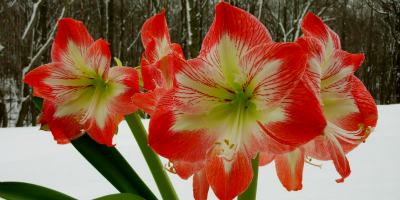
bringing nature, nurseries and gardeners together Dec 13, 2018
Nursery notes: The Natural Gardener has a generous 25% store-
wide sale on plants, pottery, rain barrels, composters... everything
except clearance items, gift cards and delivery fees. On Dec 17 it
turns into a 30% sale. / Over at Barton Springs Nursery you'll find
four inch Lindheimer muhly for 99 cents, all citrus 25% off, and
some 1 gal plants for $5: almond verbena, Copper Canyon daisy,
hot lips salvia and wedelia. For $4: Brazilian buttonflower, dwarf
lions tail and hummingbird plant. Support local nurseries! ❦

Chris Winslow writes: 'While I miss our customers and the inter-
esting daily conversations, I am also getting adjusted to being
retired... sort of ; - ) Let's call it an active retirement. Just yesterday
I was fishing with a friend at Sundown Bay near Goose Island State
Park and we got to witness these whooping cranes having some
kind of a disagreement, arguing, and dancing - and then some of
them took off and swooped low just over our heads. We're talking
birds that are 7 foot tall! An exciting moment.
My new garden in Rockport is still in the planning stages, but the
idea is for it to be a massive plot full of bee, butterfly and humming-
bird-friendly perennials. It's going to be stunning!
I still sometimes drive by It's About Thyme. To see the lot empty
is enough to make you cry. Especially seeing the construction that's
happening right next to western side. They are building on top of
the site of our overflow parking.
I miss the smell of the rosemary and all of the herbs and flowers as
I walked through the greenhouses, and the coming and going of
customers and beautiful plants. When you do something for 50 years,
and then suddenly stop, it is obvious that you're going to miss it. A
big thank you from Diane and I for all of your kind emails and phone
calls of support. Happy Holidays! ❦
____________________________________________________
Create your own herbal wreath: add some DIY holiday decor
to your house with this easy project. With a wreath frame, wire,
some hardy herbs (such as rosemary, sage, thyme, and bay leaf),
you'll quickly be on your way to making something that's fragrant,
and beautiful. Real Simple ❦
____________________________________________________
The Austin Garden is sponsored by Hays Free Press

____________________________________________________
Central Texas Gardener: An in-studio chat with authors Lynne
and Jim Weber about their new book 'Native Host Plants for Butter-
flies.' On tour a visit to a Blanco garden which mixes structure with
native plants. Learn about the benefits of calendulas for bees and
butterflies, and also how to make a healing salve from oil-infused
petals. Saturday 4 p.m., Sunday 9 a.m. KLRU ❦

Christmas Plants Guide
by Amanda Moon
Christmas and other winter holidays bring out the desire to fill our
homes with greenery and decorative flowers. With a little extra
care and forethought, many of these wonderful plants can continue
to thrive long after December becomes just a distant memory.
Choosing a living Christmas tree is a great place to start. You can
have it indoors for the holiday season, and then enjoy it for the
rest of the year as a beautiful addition to your landscape.
The trick is to choose the right type of tree that can survive indoors
for three weeks or so, and then thrive in our soil and climate.
Some options to consider are Leyland Cypress and Arizona Cyp-
ress. If you live in the Elgin-Bastrop area then the Afghan Pine is
a good choice. It will grow west of that area, but will not grow
quite as strong because of our alkaline soil.
Hollies and asparagus fern are two other outdoor plants that look
pretty when decorated for winter and are then planted in the land-
scape. Just make sure you give them even water while still in the
containers, and remove any decorative sleeves that prevent water
from draining (or punch holes in the bottom).
If you're looking for a permanent indoor or porch tree, then the
Norfolk Island pine can be a nice addition that you can decorate
for Christmas and then use as a centerpiece of your indoor green-
ery for the next year.
Rosemary Christmas trees are always available this time of year
and many people buy them for centerpieces in their home. However
there is a problem with this: rosemary absolutely has to be in the
sun and will crash if kept inside for more than a few days (at most).
But in a sunny spot on the porch it will thrive and then you can
plant it as a full sun, evergreen anchor piece in your landscape
after Christmas.
Greenery on your porch can also add to your outdoor decorations
and looks beautiful when it's decked out in lights and ribbons.
A native of Mexico, poinsettias have been an important part of
the Christmas tradition in that country for nearly 500 years.
Brought into the United States in the mid-19th century, we have
enjoyed their colorful bracts in our homes each December now
for generations. Poinsettias are typically grown for the holidays
and then discarded in January after the season is over.
If you want to keep your poinsettia growing, water only enough
to keep the leaves from wilting. Too much water (especially when
covered in non-draining metallic florist sleeves) is the biggest
detriment to keeping your poinsettia looking its best throughout
December and into the new year.
After all danger of frost has passed, gradually move the pot out to
a shady location on a porch and repot into a bigger container.
When handling poinsettias wear gloves if you are sensitive to the
milky sap produced by the Euphorbia family. The sap can be an
irritant to some and can irritate a pet’s mouth if eaten.
Finally, Christmas cactus and amaryllis are two of my favorite
holiday plants. They're easy to grow and will reward you with years
of blooms with little care.
Amaryllis is a true bulb that typically blooms in the late spring.
I buy a new one every year and plant them into large mixed tubs
to create a beautiful spring display. My favorite varieties? Apple
Blossom and Papilio. Many amaryllis can be planted in the ground
here and will overwinter and multiply in all but the coldest years.
Christmas cactus is a succulent that will bloom the next Christmas
with just a little care. Be careful not to leave the plant in the foil
sleeve it comes in. Too much water will kill it quick! In January
pot it up into a clay pot with a good draining soil.
Grow in an eastward / northward facing location and water only
when dry. Buds should start to form again early the next December.
A little organic fertilizer will help it to bloom even stronger.
With just a little care, your plants purchased during the holiday
season can become a source of beauty into the new year.
Happy Gardening Everyone! ❦

